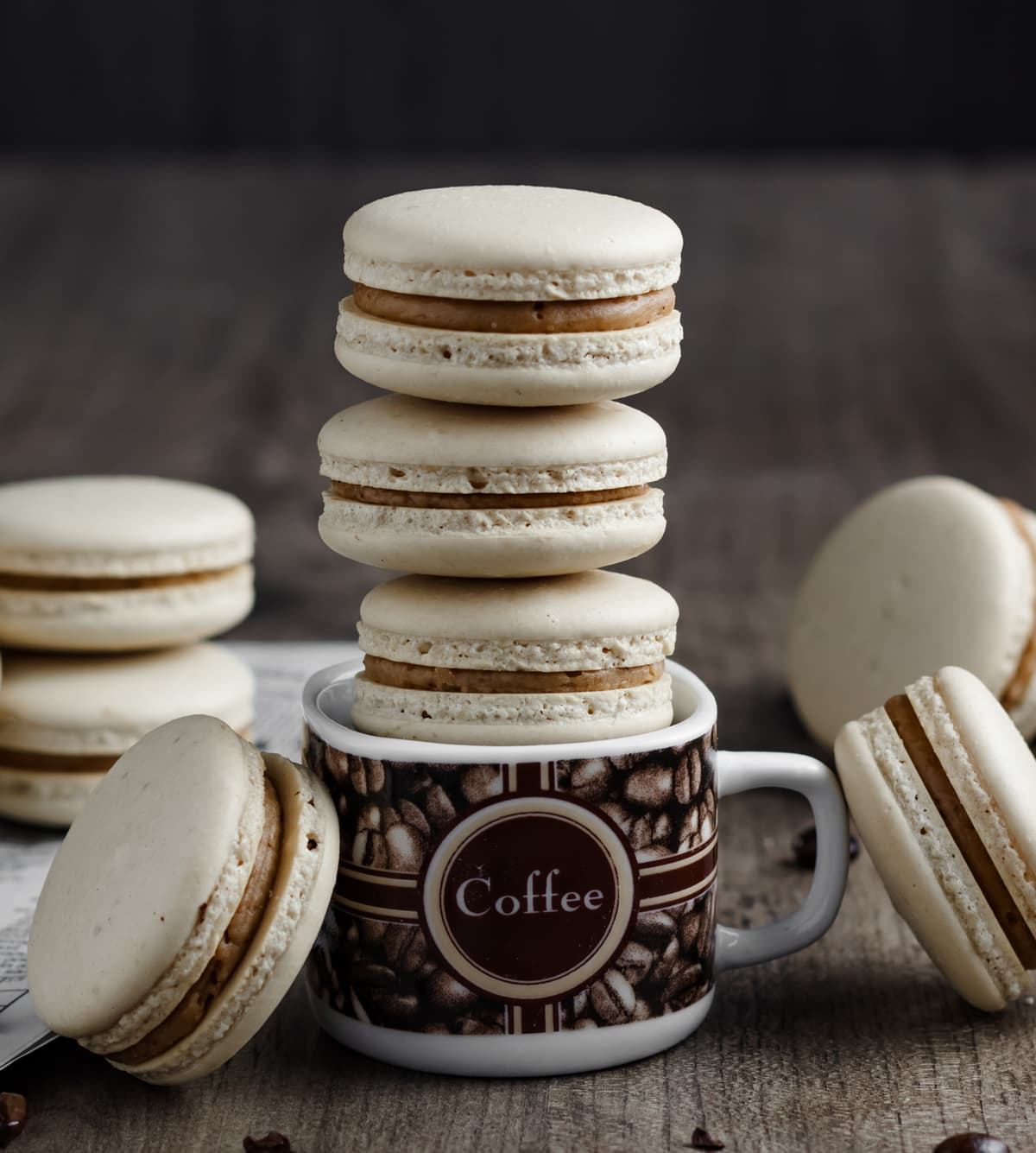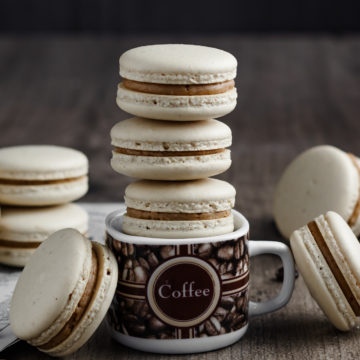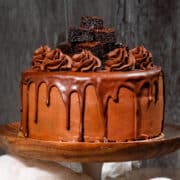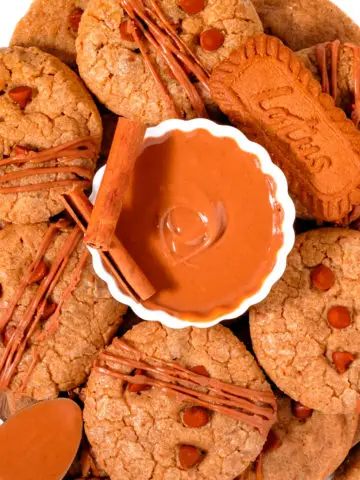These coffee macarons are the perfect way to start your morning! They are made with French macaron cookie shells flavored with espresso powder and filled with a coffee espresso buttercream.
 If you love coffee and want to try something new and seriously delicious, these coffee macarons are just the thing! Using espresso powder is great for adding strong coffee flavor to the macaron shells and to the coffee buttercream. It also adds a kick of caffeine to give you a burst of energy when you need one!
If you love coffee and want to try something new and seriously delicious, these coffee macarons are just the thing! Using espresso powder is great for adding strong coffee flavor to the macaron shells and to the coffee buttercream. It also adds a kick of caffeine to give you a burst of energy when you need one!
Even if you aren't a fan of coffee, these macarons make perfect gifts for those who are. A few of these wrapped up alongside a coffee shop gift card and you have a cute, unique, personalized gift that coffee lovers will absolutely adore!
WHAT ARE MACARONS?
Not to be confused with macaroons, which are coconut cookies, French macarons are delicate sandwich cookies made with almond flour and meringue. The shells have a mild, sweet, slightly nutty flavor and are usually sandwiched between a frosting or other type of filling.
Macarons are deceptively small and simple looking, but they are actually considered one of the hardest desserts to make! There is a lot of accuracy and precision involved, and you won't know if you've done everything right until they come out of the oven. The good news is you only need a few ingredients to make them, and even when they don't look perfect, they always taste amazing!
MERINGUE FOR MACARONS
Macarons can be made with a French, Swiss, or Italian meringue. No one method is necessarily better than the other, it just depends on what you feel most comfortable with or works best for you.
The French method is the most basic and is a great place to start if you're new to meringue or to making macarons. Most professional pastry chefs use the Italian method, which is the most advanced but also makes the most stable meringue. The Swiss method is less common and is somewhere in between the two.
This recipe for coffee macarons uses a French meringue.

WHAT YOU NEED TO MAKE COFFEE MACARONS
SPECIAL EQUIPMENT:
- Bowls and mixers: Several large bowls and an electric or stand mixer. Unlike Swiss and Italian meringue, a French meringue can be made just as easily with a hand-held mixer.
- Food scale: Keeps everything accurate, which is crucial for making macarons! This food scale is hands-down my favorite piece of kitchen equipment, it makes baking so much easier and practically eliminates the need for measuring cups.
- Piping bag and round piping tip: For piping the macaron batter, I recommend using a ¼-½" round piping tip.
- Baking sheet: For macarons you want to use a sturdy baking sheet that won't warp in the oven. You can also double stack your baking sheets to keep them from warping.
- Silicone baking mat or parchment paper: For piping the macaron batter onto. If you make macarons often enough a silicone mat is definitely worth the investment. I find it easier and the batter doesn't spread as much as with parchment paper. Whatever you use make sure it's slightly smaller than your baking sheet. Otherwise you'll have a few lopsided shells.
- Template: A lot of silicone baking mats come with macaron templates printed on them. You can also make your own by tracing 1.5" circles onto a sheet of parchment paper.
INGREDIENTS:
- Almond flour: Almond flour is made from blanched ground almonds and is what gives macarons their unique taste and texture. Not all brands are equal, some tend to be less fine and more oily than others. My favorite brand that I always use is Blue Diamond almond flour.
- Powdered sugar: Sifted with the almond flour to make up the dry ingredients. Powdered sugar is crucial in macarons developing feet during baking.
- Espresso powder: Just a small amount adds plenty of coffee flavor to the shells and the frosting.
- Egg whites: Separate the eggs while they're cold and then let them come to room temperature for about 30 minutes-1 hour. Eggs separate easier when they're cold and egg whites whip to stiff peaks easier and to a greater volume when they're at room temperature.
- Cream of tartar: An acid that stabilizes the egg whites.
- Granulated sugar (sifted): Gives the meringue structure.
COFFEE BUTTERCREAM
- Butter: Unsalted and softened to room temperature.
- Powdered sugar
- Espresso powder
- Cocoa powder
- Cream: Or milk

HOW TO MAKE COFFEE MACARONS
Separate the eggs while they're cold, then set the whites aside to come to room temperature. Make sure you don't get any of the yolk in the bowl with the whites or you won't be able to whip them to stiff peaks.
Sift the granulated sugar into a small clean bowl and set aside.
Sift the almond flour back and forth between 2 bowls, discard any larger chunks that are left at the bottom of the sifter.
Place a large bowl on your kitchen scale and set the scale to 0 (in grams). Add 100 grams of the sifted almond flour, 135 grams of powdered sugar, ⅛ teaspoon salt, and 1 and ½ teaspoons of espresso powder. Transfer everything to a food processor and pulse for about 15-30 seconds, then sift everything together in one bowl. Set aside until needed.
MAKE THE MERINGUE
Use a hand-held mixer or the whisk attachment in your stand mixer to whip the room temperature egg whites and cream of tartar for about 1 minute or until starting to thicken and increase in volume.
With the mixer running, add the sifted granulated sugar, about 2 teaspoons at a time, and mix for 20 seconds after each addition. Once all of the sugar is added, mix until the meringue reaches medium-stiff peaks. When you lift the mixer out of the bowl and flip it upside down there should be a peak that sticks up with a very slight droop at the tip.

MACARONAGE
Macaronage is the process of combining the dry ingredients and meringue to make a macaron batter.
In 3 additions, gently fold the meringue into the dry ingredients by wiping around the sides and bottom of the bowl. It will be thick and pasty after the first addition. Wipe any batter or meringue off of the spatula as needed.
After the last addition, continue to fold by wiping the sides and the bottom of the bowl. Take your time and check often for signs it's getting close to the right consistency. It should be smooth and flow off of the spatula in thick ribbons without breaking.

PIPE THE COFFEE MACARON BATTER
Add the macaron batter to a large piping bag fitted with a small round piping tip.
Hold the bag straight up and down with the tip right in the center of the circle on your template. Gently squeeze the batter out from the center until it fills the circle. Stop squeezing and lift up with a quick twisting motion. See here: How to Pipe Macaron Batter

Once you've piped all of the shells, lift the pan up and drop or bang it firmly on your counter several times. You can also just hit the bottom of the pan with your hand several times if you don't want to drop it on your counter.
DRY THE SHELLS
Let the shells dry out for 30-45 minutes, or until they form a skin on the surface. You should be able to gently touch the tops without wet batter sticking to your finger.
BAKE
Arrange your oven rack to the middle position and preheat your oven to 300°F/150°C. Bake the macarons, one baking sheet at a time, for 15-17 minutes.

Remove from the oven and let the macaron shells cool completely on the baking sheet for at least 30 minutes before touching or removing them.
MAKE THE COFFEE BUTTERCREAM
In a medium bowl, use an electric mixer to beat the softened butter until smooth. Add the powdered sugar, instant espresso powder, cocoa powder, and cream (or milk), and mix until the frosting is smooth.

Add the frosting to a large piping bag and pipe a dollop of the frosting onto the bottom of one macaron shell. Gently top with a second shell.
HOW TO STORE MACARONS
Macarons taste best a day or two after they've been filled and stay fresh for one week in the fridge. Store them in an airtight container and keep in the fridge, you can also freeze the shells, filled or unfilled, for up to 2 months.
To freeze: Place the macarons in a single layer on a baking sheet and set the sheet flat in the freezer until the shells are completely solid. Then transfer to a sealed container that will protect them from getting squished. Keep frozen for 2 months.

MORE MACARON RECIPES
📖 RECIPE

Coffee Macarons
Equipment
- Food processor
- electric or stand mixer
- piping bag and round piping tip
- 2 Silicone baking mats or parchment paper
- macaron template
Ingredients
Coffee Macaron Shells:
- 100 grams almond flour
- 135 grams powdered sugar
- 1 and ½ teaspoons espresso powder
- ⅛ teaspoon salt
- 100 grams egg whites
- ¼ teaspoon cream of tartar
- 120 grams granulated sugar, sifted
Coffee Buttercream:
- ½ cup unsalted butter, softened to room temperature
- 1 and ½ cups powdered sugar
- ⅛ teaspoon salt
- 2 teaspoons espresso powder
- 1 teaspoon cocoa powder
- 1 tablespoon cream, or milk
Instructions
- Line two large baking sheets with parchment paper or silicone baking mats with macaron templates. You can make a homemade macaron template by tracing 1.5" circles onto parchment paper. Cover the homemade template with a sheet of parchment paper so it stays clean.
- Separate the eggs while they're cold and then set them aside to come to room temperature for at least 30 minutes. Make sure you don't get any yolk in the bowl with the whites or you won't be able to whip them to stiff peaks. Sift the granulated sugar into a small bowl and set aside.
- Sift the almond flour back and forth between two bowls. Discard any larger chunks left at the bottom of the sifter each time. From the sifted almond flour, measure 100 grams into a large bowl and sift in 135 grams of powdered sugar, 1 and ½ teaspoons espresso powder, and ⅛ teaspoon of salt. Add the dry ingredients to a food processor and pulse for about 30 seconds. Then sift everything back into a large bowl and set aside.
Make the Meringue:
- Add the egg whites to a completely clean and dry bowl or bowl of a stand mixer fitted with a whisk attachment. Begin whipping the egg whites on medium speed for about 30 seconds or until foamy. Add the cream of tartar and whip for another 30 seconds-1 minute until starting to thicken and increase in volume.
- With the mixer running, begin adding the sifted granulated sugar, about 2 teaspoons at a time, and mix for 20 seconds after each addition. Once all of the sugar is added keep mixing until the meringue reaches medium-stiff peaks. If you lift the mixer up out of the bowl and flip it upside down there should be a peak that sticks up with just a slight droop at the tip.
Macaronage:
- In 3-4 additions, use a rubber spatula to gently fold the meringue into the dry ingredients. It will be thick and pasty at first. Keep folding by wiping the sides and bottom of the bowl with a rubber spatula.
- After all of the meringue is added, fold until the batter flows in thick ribbons from your spatula without breaking. If you lift the batter up and draw a figure 8, it should disappear into the batter after about 10 seconds. If it doesn't disappear or if the batter breaks off of the spatula, keep folding and check again after every few turns.
- Pipe the shells: Add the macaron batter to a large piping bag with a ¼-½" round piping tip. Hold the piping bag straight up and down with the tip right in the center of the circle on your template. Squeeze the batter out from the center until it fills the circle, then lift up with a quick twisting motion. See here: How to Pipe Macaron Batter
- Once you have all of the shells piped, lift the pan up and drop or bang it firmly on your counter several times to get rid of any trapped air bubbles.
- Let the macaron shells dry out at room temperature for at least 30 minutes, or until they form a skin on the surface. You should be able to gently touch the tops without wet batter sticking to your finger.
- Bake: Arrange your oven rack to the middle position and preheat your oven to 300°F/150°C. Bake one sheet of macarons at a time, for 15-17 minutes each. Take the sheet out of the oven and let the shells cool completely before touching or trying to remove them from the pan.
Make the Coffee Buttercream:
- Use an electric mixer to beat the softened butter until fluffy and smooth. Add the powdered sugar, salt, espresso powder, cocoa powder, and cream (or milk), and mix until smooth.
- Once the macaron shells have cooled, use a piping bag to pipe a dollop of frosting onto the bottom of one shell, then gently top with a second shell.
- Once filled, macarons taste best after 24 hours and stay fresh in the fridge for 1 week. They can also be frozen for 1 month.


















Leave a Reply